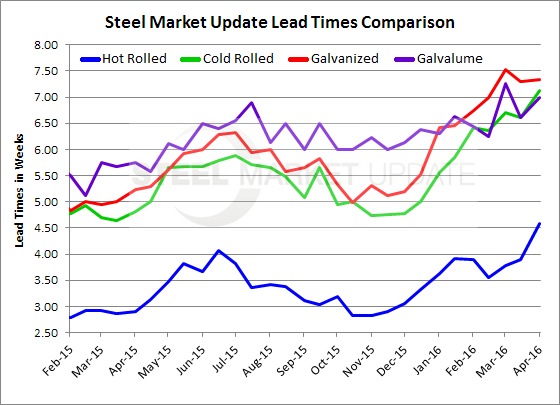SMU Data and Models

Steel Mill Lead Times Continue to Move Out
Written by John Packard
April 7, 2016
Steel mill lead times on all four flat rolled products have become more extended, according to those who responded to our most recent flat rolled steel market analysis. As lead times extend, steel buyers have to place more orders in order to protect their inventories. The more orders placed, the better chance for the domestic steel mills to collect higher flat rolled steel spot prices.
As our regular readers know, Steel Market Update writes articles about flat rolled steel mill lead times based on two sources: our twice monthly surveys and directly from steel buyers who receive lead time sheets from the mills (or receive them verbally). The following data is based on the lead times collected from our latest survey which concluded on Thursday (earlier today) of this week.
Hot rolled lead times averaged out to 4.59 weeks, 0.69 weeks higher than our last survey. This time last year they were 2.91 weeks.
The average lead time for cold rolled was 7.12 weeks, up from 6.60 in mid-March. One year ago lead times were 4.82 weeks.
Galvanized lead times were steady at 7.33 weeks. This time last year they were 5.24 weeks.
Galvalume lead times averaged 7.00 weeks, up 0.40 weeks from our last survey. One year ago they were 5.75 weeks.
To see an interactive history of our Steel Mill Lead Time data, visit our website here.

John Packard
Read more from John PackardLatest in SMU Data and Models

SMU’s June at a glance
A look at SMU data for the month of June.

SMU Survey: Buyers’ Sentiment rebounds from multi-year low
Both of SMU’s Steel Buyers’ Sentiment Indices edged higher this week. Current Sentiment rebounded from a near five-year low, while Future Sentiment rose to a two-month high

SMU flat-rolled market survey results now available
SMU’s latest steel buyers market survey results are now available on our website to all premium members.

SMU Survey: Sheet lead times pull back after early-June blip, plate holds
Following the uptick seen two weeks ago, lead times eased this week for all four sheet products tracked by SMU, while plate lead times held steady, according to this week’s market survey.

SMU Survey: Pricing power abruptly shifts to steel buyers
The majority of steel buyers responding to our latest market survey say domestic mills are more willing to talk price on sheet and plate products than they were earlier this month. Sheet negotiation rates rebounded across the board compared to early June, while our plate negotiation rate hit a full 100%.

